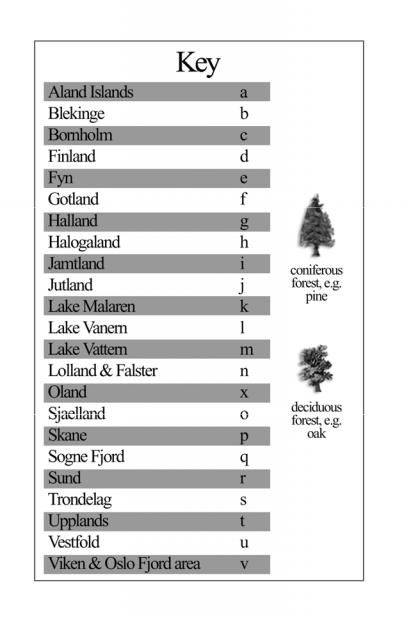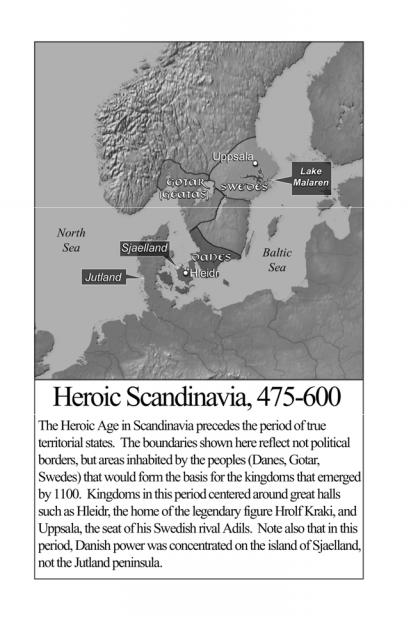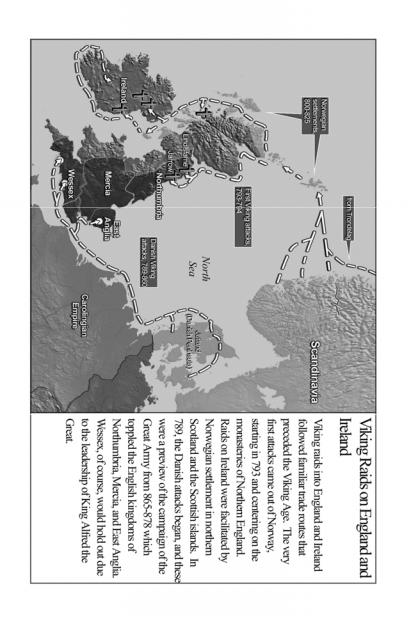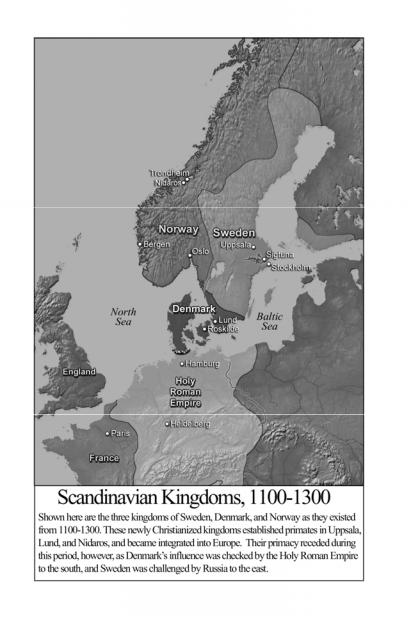
- •The Vikings
- •Part I
- •Professor Kenneth W. Harl
- •Kenneth W. Harl, Ph.D.
- •Table of Contents
- •The Vikings
- •Part I
- •The Vikings
- •Lecture One
- •The Vikings in Medieval History
- •Outline
- •Lecture Two
- •Land and People of Medieval Scandinavia
- •Outline
- •Lecture Three
- •Scandinavian Society in the Bronze Age
- •Outline
- •Lecture Four
- •Scandinavia in the Celtic and Roman Ages
- •Outline
- •Lecture Five
- •The Age of Migrations
- •Outline
- •Lecture Six
- •The Norse Gods
- •Outline
- •Lecture Seven
- •Runes, Poetry, and Visual Arts
- •Outline
- •Lecture Eight
- •Legendary Kings and Heroes
- •Outline
- •Lecture Nine
- •A Revolution in Shipbuilding
- •Outline
- •Lecture Ten
- •Warfare and Society in the Viking Age
- •Outline
- •Lecture Eleven
- •Merchants and Commerce in the Viking Age
- •Outline
- •Lecture Twelve
- •Christendom on the Eve of the Viking Age
- •Outline
- •Timeline
- •Maps
- •The Vikings
- •Part II
- •Professor Kenneth W. Harl
- •The Teaching Company ®
- •Kenneth W. Harl, Ph.D.
- •Table of Contents
- •The Vikings
- •Part II
- •The Vikings
- •Lecture Thirteen
- •Viking Raids on the Carolingian Empire
- •Outline
- •Lecture Fourteen
- •The Duchy of Normandy
- •Outline
- •Lecture Fifteen
- •Viking Assault on England
- •Outline
- •Lecture Sixteen
- •The Danelaw
- •Outline
- •Lecture Seventeen
- •Viking Assault on Ireland
- •Outline
- •Lecture Eighteen
- •Norse Kings of Dublin and Ireland
- •Outline
- •Lecture Nineteen
- •The Settlement of Iceland
- •Outline
- •Lecture Twenty
- •Iceland—A Frontier Republic
- •Outline
- •Lecture Twenty-One
- •Skaldic Poetry and Sagas
- •Outline
- •Lecture Twenty-Two
- •Western Voyages to Greenland and Vinland
- •Outline
- •Lecture Twenty-Three
- •Swedes in the Baltic Sea and Russia
- •Outline
- •Lecture Twenty-Four
- •The Road to Byzantium
- •Outline
- •Maps
- •Biographical Notes
- •The Vikings
- •Part III
- •Professor Kenneth W. Harl
- •The Teaching Company ®
- •Kenneth W. Harl, Ph.D.
- •Table of Contents
- •The Vikings
- •Part III
- •The Vikings
- •Lecture Twenty-Five
- •From Varangians into Russians
- •Outline
- •Lecture Twenty-Six
- •Transformation of Scandinavian Society
- •Outline
- •Lecture Twenty-Seven
- •St. Anskar and the First Christian Missions
- •Outline
- •Lecture Twenty-Eight
- •Formation of the Kingdom of Denmark
- •Outline
- •Lecture Twenty-Nine
- •Cnut the Great
- •Outline
- •Lecture Thirty
- •Collapse of Cnut’s Empire
- •Outline
- •Lecture Thirty-One
- •Jarls and Sea Kings of Norway
- •Outline
- •Lecture Thirty-Two
- •St. Olaf of Norway
- •Outline
- •Lecture Thirty-Three
- •Kings of the Swedes and Goths
- •Outline
- •Lecture Thirty-Four
- •Christianization and Economic Change
- •Outline
- •Lecture Thirty-Five
- •From Vikings to Crusaders
- •Outline
- •Lecture Thirty-Six
- •The Viking Legacy
- •Outline
- •Maps
- •Glossary
- •Bibliography
Lecture Twenty-Four
The Road to Byzantium
Scope: In the late 9th and 10th centuries, the Swedish Rus developed a new primary trade route from Novgorod to Kiev on the Dneiper and, thence, to the Black Sea and Constantinople, capital of the Byzantine Empire. This route required far more organization than that on the Volga. South of Kiev, Turkomen Pechenegs dominated the steppes. The Rus risked attack by Pecheneg horse archers when they took ships and cargo overland to avoid rapids on the lower Dneiper. The Rus coveted Constantinople (ON: Miklagard, “Great City,”), the seat of a powerful Macedonian bureaucratic state, as the source of silks and gold. In 860, the jarls Askold and Dir launched the first Viking attack on Constantinople. Their fleet of 200 ships was driven off by the imperial navy, equipped with Greek fire. Prince Oleg, who moved his capital from Novgorod to Kiev, led a more successful attack in 907, gaining a commercial treaty from the emperor in 911. His successor, Igor, launched Viking fleets against Constantinople, winning his own treaty in 945. Trade and mercenary service was far more common. In the Byzantine emperors, the Rus found employers who paid well. From the mid-10th century on, Varangians arrived from Scandinavia to serve in imperial armies. Most important for Russian history was Prince Vladimir’s conversion to Orthodox Christianity in 988–989.
Outline
I.The creation of the Rus state eventually gave rise to Orthodox Russia.
A.The shift in the axis of trade from the Volga to the Dneiper in 840–860 was of major historical consequence. Increasingly, Scandinavians in Russia would direct their interests toward Constantinople.
B.Along the Volga River route, the Rus had come into contact with Muslims and probably coveted Muslim jewelry and decorative objects. Such contact might have led the Scandinavian world into closer alignment with the Islamic world and, perhaps, to conversion to Islam. Instead, by 975, the Volga trade route had declined to secondary importance, and the Rus had redirected their interests to the Dneiper
C.As a result, the Rus, or Varangians, would come into greater contact with Orthodox Christianity, instead of Islam. This would be a decisive factor in Russia’s development and the course of European history.
D.This lecture traces the first century of Rus contact with the Byzantine world. The next lecture traces the transformation of the Rus into Slavic Orthodox Christians.
II.The shift in trade routes is attested by archaeological evidence and Byzantine accounts. It is also borne out by a very peculiar source, the Russian Primary Chronicle (c. 1115).
A.This document was penned by a monk outside Kiev and written in a literary Slavic language, Old Church Slavonic. It records a good deal of information about Rus princes from a Slavic viewpoint. It contains some exaggerations but also preserves the treaties negotiated by the Rus princes with the government of Constantinople.
B.The Russian Primary Chronicle tells us that the Rus had been living among the Slavs from at least the 9th century. In c. 860, the Slavic tribes were warring among themselves and appealed to a Rus leader, Rurik (ON: Erik), to rule over them according to customary law.
C.The Rus established a capital at Novgorod, and Rurik sent two of his boyars, Dir (ON: Dyr) and Askold (ON: Höskuld) to establish a position at Kiev. They built a fortified post, equipped a 200-ship fleet, sailed down the Dneiper to the Black Sea, and attacked Constantinople. Byzantine accounts back up the description of this activity in the Russian Primary Chronicle.
D.The attack frightened the Byzantines. As Emperor Michael III (r. 842–867) was fighting on the eastern frontier, the patriarch, Photius (r. 858-867 and 878–886) took it upon himself to organize the city’s defense. The imperial fleet sailed out and routed the Vikings.
1.This was the Vikings’ first experience of significant naval power.
2.The imperial fleet’s secret weapon was Greek fire, a petroleum incendiary the Byzantines sprayed from siphons onto enemy ships.
3.Despite the Vikings’ defeat, the imperial government was impressed by their unexpected attack. Michael III forged an agreement to forestall future raids and probably bestowed certain trade
©2005 The Teaching Company Limited Partnership |
37 |
considerations. In the 10th century, a number of Rus, or Varangians passed into imperial service as sailors and marines.
E.In his De Administrando Imperio (“On the Governing of the Empire”), a handbook for dealing with barbarians, Constantine VII (r. 913-957) notes that the lower Dneiper rapids were given Norse names, indicating that the Norse were likely the first to negotiate them.
III. Constantinople was a great walled city, seen by the Rus as a challenge.
A.The prince who followed Rurik, Oleg (ON: Helgi, r. c. 879–913), relocated his capital from Novgorod to Kiev. Henceforth, leading Rus princes looked directly toward the Black Sea and Constantinople.
B.Oleg reportedly launched his own attack in 907. The Russian Primary Chronicle exaggerates his forces to 2,000 ships and 80,000 warriors.
1.Oleg cleverly avoided the imperial fleet, landed north of the Golden Horn, and tried to move his forces against the vulnerable northeastern sections of Constantinople.
2.This attack was countered and the Rus pulled back, but a treaty between Oleg and the imperial government established the Rus as favored residents and merchants in Constantinople.
3.Terms were also established to encourage the Rus to convert to Orthodox Christianity and to join the emperor’s military service.
C.The contact with Constantinople was important to the Rus, who were living far from Roman civilization. As a result of their exploitation of trade routes, they encountered the government of Constantinople and brought Byzantine political organization and institutions to Russia.
D.After concluding the treaty, Oleg returned to Kiev and imposed his authority across the forest zones of Russia. He is remembered in the Russian Primary Chronicle as the builder of many fortified posts and founder of later Russian cities. At the same time, Scandinavian sources speak of Russia as Gardariki, “the kingdom of fortified posts.”
E.Oleg’s successor was Igor (ON: Ingvar, r. 913–945), who claimed to be a son or grandson of Rurik. He launched two attacks against Constantinople to pressure the imperial government into giving him a more favorable treaty. In 945, a second treaty was concluded, which expanded advantages for the Rus operating in Constantinople.
1.The 911 treaty witnesses on the Rus side were all Scandinavian; In 945, many of the Rus side treaty witnesses seem to be Slavic.
2.10th -century Scandinavians became assimilated in Russia as a colonial population, similar to the Hiberno-Norse in Ireland.
3.The description we have of Igor’s son Sviatoslav by a Byzantine monk also reveals this assimilation. Sviatoslav seems to have resembled a Khazar kagan more than a Viking sea king.
F.The 945 treaty resulted in the arrival in Constantinople of more Rus from Russia and more Vikings from the Scandinavian homeland. In about 957, for example, Queen Olga (ON: Helga), Sviatoslav’s mother, made a great state visit to Constantinople, attended a mass at Hagia Sophia, and converted to Orthodox Christianity.
G.Sviatoslav saw Constantinople as a challenge, just as his father and grandfather had, and he carried out the last of the serious attacks on the Byzantine Empire.
1.In 965–966, hostilities erupted between the Kingdom of Bulgaria and the Byzantine Empire. In 967, the Byzantine emperor, Nicephorus II Phocas, convinced Sviatoslav to attack the Bulgarians as a Byzantine ally.
2.Sviatoslav, who had just crushed the power of the Khazar khanate on the lower Volga, obliged. He invaded and defeated Bulgaria, then proceeded to attack imperial territory with the goal of taking Constantinople.
3.This action precipitated a crisis in the imperial government. Nicephorus was murdered by his nephew John Tzimisces, who took over as emperor and opened a counteroffensive in 971. John drove back the Rus and defeated Sviatoslav in a siege at a Roman military fortress at Durostorum on the Danube.
H.This invasion by Sviatoslav marked an important departure in Rus-Byzantine relations.
1.The imperial government was stunned by the size and organization of the campaigns.
2.To carry out these campaigns, Sviatoslav must have tapped into the great reservoir of manpower among his Slavic subjects.
38 |
©2005 The Teaching Company Limited Partnership |
I.Sviatoslav finally agreed to pull out of Bulgaria and, on his return, he and his army were massacred by Pechenegs along the rapids of the lower Dneiper in the spring of 972. His death plunged the Rus state at Kiev into a succession crisis and civil war.
1.The network of fortified towns was in danger of breaking up. Many of the princes who were related to the royal family attempted to assert their authority.
2.The eventual victor in the civil war was Vladimir (ON: Valdemar, r. 980-1014), who would reunite the realm of Rurik and impose his control.
3.In the process, Vladimir learned that it was far more beneficial to play the role of an Orthodox prince and ally of Byzantium, rather than a Viking sea king. He would embrace Orthodox Christianity around 988–989 and, in so doing, laid the foundation for the creation of Russia and the transformation of Scandinavians into Slavic Orthodox Christians.
Further Reading:
S. H. Cross and O. P. Sherbowitz-Wetzor. The Russian Primary Chronicle: Laurentian Text. Cambridge, MA: Medieval Academy of America, 1973.
Mark Whittow. The Making of Byzantium, 600–1025. Berkeley: University of California Press, 1996.
Questions to Consider:
1.What are the sources for the founding of the Rus settlements of Novgorod and Kiev? What accounted for the shift of Rus activity from the Volga to the Dneiper in the 9th century?
2.Why did Constantinople impress the Rus? How did audacious Rus attacks force the Macedonian emperors to come to terms with the princes of Kiev? Why were treaties so important to Rus princes? How did the Rus regard Orthodox Christianity?
©2005 The Teaching Company Limited Partnership |
39 |

Maps
40 |
©2005 The Teaching Company Limited Partnership |

©2005 The Teaching Company Limited Partnership |
41 |

42 |
©2005 The Teaching Company Limited Partnership |

©2005 The Teaching Company Limited Partnership |
43 |

44 |
©2005 The Teaching Company Limited Partnership |

©2005 The Teaching Company Limited Partnership |
45 |
